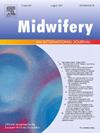评估共同设计的服务改进数字动画(DAISI),分享有关可修改行为的信息,以减少死产风险
IF 2.6
3区 医学
Q1 NURSING
引用次数: 0
摘要
在英国,与白人女性相比,少数族裔女性的死产率更高。为了解决这一差异,联合制作了一部数字动画《死产DAISI》(改进服务的数字动画),用阿拉伯语、英语和乌尔都语传播有关可减少死产风险的健康行为的信息。目的评估死产dais的可接受性和可及性及其对死产知识和可降低死产风险的健康行为的影响。方法对29名少数民族妇女进行结构化电话访谈,包括阿拉伯语、英语和乌尔都语。在怀孕16-20周期间,在提供死产DAISI之前,参与者被问及他们的人口统计学特征,死产知识和减少死产风险的行为。在怀孕24-28周期间,参与者被问及同样的问题,以及她们使用DAISI的想法和体验。所有参与者都参加了死产调查,并表现出死产知识的增加和减少死产风险的行为。知识得分中位数由第一次访谈的5/14 [IQR 4-6.25]上升至第二次访谈的11/14 [IQR 9.75-12] (p <;0.001)。与会者认为,大信息系统是一种可接受和可利用的资源,提供了重要的健康信息。结论死产信息系统是向少数民族妇女以不同语言进行死产预防信息交流的有效手段。需要进一步的研究来确定知识的改善是否转化为更公平的妊娠结局。本文章由计算机程序翻译,如有差异,请以英文原文为准。
Evaluation of a co-designed digital animation in service improvement (DAISI) sharing messages around modifiable behaviours to reduce the risk of stillbirth
Background
In the United Kingdom, women from minoritised ethnic backgrounds experience increased rates of stillbirth compared to White women. To address this disparity, a digital animation, the Stillbirth DAISI (Digital Animation in Service Improvement), was co-produced to communicate messages in Arabic, English and Urdu about health behaviours that can reduce the risk of stillbirth.
Aim
To evaluate the acceptability and accessibility of the Stillbirth DAISI and its impact on knowledge of stillbirth and health behaviours that can reduce the risk of stillbirth.
Methods
Data were collected using two structured telephone interviews with 29 Arabic, English and Urdu-speaking women from minoritised ethnic backgrounds. Between 16-20 weeks of pregnancy, participants were asked about their demographic characteristics, knowledge of stillbirth and behaviours to reduce the risk of stillbirth, before being provided with the Stillbirth DAISI. Between 24-28 weeks of pregnancy participants were asked the same questions, as well as their thoughts and experience of using DAISI.
Findings
All participants accessed the Stillbirth DAISI and demonstrated increased in knowledge of stillbirth and behaviours to reduce risk of stillbirth. The median knowledge score increased from 5/14 [IQR 4-6.25] in the first interview, to 11/14 [IQR 9.75-12] in the second interview (p < 0.001). Participants thought the DAISI was an acceptable and accessible resource which provided important health messages.
Conclusion
The Stillbirth DAISI is an effective means to communicate messages about stillbirth prevention in different languages to minoritised ethnic women. Further studies are needed to determine whether improvement in knowledge translates to more equitable pregnancy outcomes.
求助全文
通过发布文献求助,成功后即可免费获取论文全文。
去求助
来源期刊

Midwifery
医学-护理
CiteScore
4.50
自引率
7.40%
发文量
221
审稿时长
13.4 weeks
期刊介绍:
Midwifery publishes the latest peer reviewed international research to inform the safety, quality, outcomes and experiences of pregnancy, birth and maternity care for childbearing women, their babies and families. The journal’s publications support midwives and maternity care providers to explore and develop their knowledge, skills and attitudes informed by best available evidence.
Midwifery provides an international, interdisciplinary forum for the publication, dissemination and discussion of advances in evidence, controversies and current research, and promotes continuing education through publication of systematic and other scholarly reviews and updates. Midwifery articles cover the cultural, clinical, psycho-social, sociological, epidemiological, education, managerial, workforce, organizational and technological areas of practice in preconception, maternal and infant care.
The journal welcomes the highest quality scholarly research that employs rigorous methodology. Midwifery is a leading international journal in midwifery and maternal health with a current impact factor of 1.861 (© Thomson Reuters Journal Citation Reports 2016) and employs a double-blind peer review process.
 求助内容:
求助内容: 应助结果提醒方式:
应助结果提醒方式:


